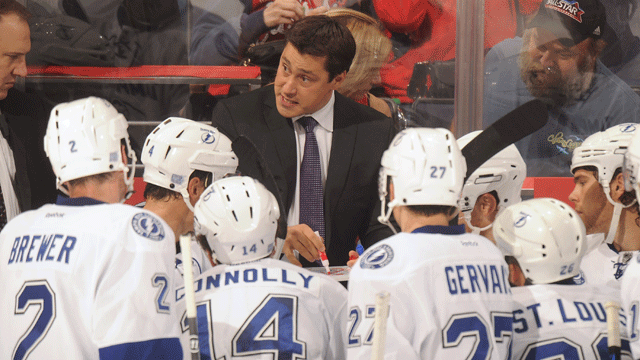 |
| Lightning are one of the few teams in the NHL that openly admit to using statistical analysis in their front office. (Getty Images) |
We still don't know exactly how many teams in the NHL are utilizing statistical analysis in their front office -- or even what they're using or how they're using it -- but it can't be ignored that a growing number of teams are adding objective data to their decision making process.
And when I say statistical analysis, I'm not simply talking about goals, assists, points, or the standard numbers you find in the box score after every game. I'm talking possession metrics like Corsi (total shot attempts) and Fenwick (shots on goal and shots that miss the net) and even right on down to detailed scoring chance data.
I wanted to take a quick look around the NHL at a handful of teams that have at least acknowledged in some way their use of data.
 Tampa Bay Lightning: The Lightning are one of the few teams in the NHL that openly advertise their use of statistics. Back in June, just before the start of free agency, they had a huge feature article on their own website talking about how general manager Steve Yzerman and the front office, including their statistical analyst Michael Peterson, would use their data in free agency, where the team eventually signed defensemen Matt Carle and Sami Salo.
Tampa Bay Lightning: The Lightning are one of the few teams in the NHL that openly advertise their use of statistics. Back in June, just before the start of free agency, they had a huge feature article on their own website talking about how general manager Steve Yzerman and the front office, including their statistical analyst Michael Peterson, would use their data in free agency, where the team eventually signed defensemen Matt Carle and Sami Salo.
The team also re-signed forward Teddy Purcell, a player that excels in a number of "advanced" statistical areas, to a long-term contract extension.
"I'm somewhat old school when it comes to the evaluating process," said Yzerman via the Lightning's website. "You ultimately watch players on tape to form your decisions, but with Michael, he takes it one step further from a statistical point of view, creates analysis and uses it to reaffirm each and every decision we make on a player. The more information we have, the better decisions we can make, and it is also useful in that it makes us go back and look at something different that we might have missed the first time around."
| More on NHL |
| Related links |
Yzerman's point at the end is, of course, the key. It's not about using any one individual thing (scouting, stats, etc.) or replacing anything, it's simply a matter of learning as much as you can. When you're investing millions of dollars in players it only makes sense. Why wouldn't you want as much information as you can get?
It even goes beyond the front office and right on down to the coaching staff as Peterson explained back in June.
"I look at faceoffs for [assistant] coach Martin Raymond each game," Peterson said. "I've started measuring a couple of extra things just to see if there would be anything surprising about our own players, and it turns out the coaches have liked that."
 Calgary Flames: Calgary is another team that at least acknowledges their use of numbers, and they're also one of the few teams in the league that make their guy, Chris Snow, available for interviews (I spoke to him last summer).
Calgary Flames: Calgary is another team that at least acknowledges their use of numbers, and they're also one of the few teams in the league that make their guy, Chris Snow, available for interviews (I spoke to him last summer).
Before joining the Flames, Snow worked in a similar capacity for the Minnesota Wild under general managers Doug Risebrough and Chuck Fletcher after he spent time working as a baseball beat writer covering the Boston Red Sox (one of the major league baseball teams that relied heavily on statistical analysis).
His official title with the Flames is listed as Director of Video and Statistical Analysis. The Flames, like any other NHL team, offer no concrete information as to what they're using or how they're using it, but they did put together a video for their website that featured Snow talking about their PUCKS software.
 Pittsburgh Penguins: Shortly after the Penguins won the Stanley Cup in 2009 I had an opportunity to interview their general manager, Ray Shero, and I asked him if the team used any sort of statistical analysis in their front office. He seemed almost hesitant to admit it at the time, but did acknowledge that they used "some" statistics.
Pittsburgh Penguins: Shortly after the Penguins won the Stanley Cup in 2009 I had an opportunity to interview their general manager, Ray Shero, and I asked him if the team used any sort of statistical analysis in their front office. He seemed almost hesitant to admit it at the time, but did acknowledge that they used "some" statistics.
"We mainly break things down with scouting and video," said Shero at the time. "But we've taken a look at a lot of the statistical analysis out there, but at the end of the day I'm not quite certain what they're telling us, to be honest with you. Again, we do use some of it, but I can't say we're overly involved in breaking down the statistics. I mean, we're not in the Moneyball thing here, in my opinion, so we're not really into that at this point."
Maybe not at that point they weren't, but in recent years their use of numbers in the front office and coaching staff has seemed to increase.
Their director of player personnel, Dan MacKinnon, spoke with James Mirtle of the Globe and Mail last September and said that the 2010-11 season was when they really felt they were on to something. He told Mirtle, "We're getting some powerful insight into things that you just can't track with the naked eye or traditional statistics.”
(It's possible that at least one of those insights could have been telling players like James Neal the best places to shoot from on the ice.)
Just because it needs to be pointed out, I work out of Pittsburgh and have an opportunity to see them and be around them quite a bit, and it hasn't been hard over the past year to pick out some subtle hints when talking to coach Dan Bylsma about their use of numbers. It could be anything from Bylsma's description of how they track and chart scoring chances, to some comments about defenseman Paul Martin having more value (which, according to numbers like Corsi and Fenwick ... he probably does).
 Carolina Hurricanes: This kind of came up recently, and it's not known just how involved the Hurricanes are (an interview request to the team was turned down), but when the club signed forward Alexander Semin to a one-year contract last week general manager Jim Rutherford made sure to point out that a lot of statistical data that went into their decision to sign him.
Carolina Hurricanes: This kind of came up recently, and it's not known just how involved the Hurricanes are (an interview request to the team was turned down), but when the club signed forward Alexander Semin to a one-year contract last week general manager Jim Rutherford made sure to point out that a lot of statistical data that went into their decision to sign him.
As I pointed out earlier this week, prior to Semin's signing with the Hurricanes he was a popular player among the statistical analysis community in hockey because of how well he consistently rates out in the advanced categories, and Rutherford's comments (like the ones he made to Bob Wage at Hurricanes blog Canes Country) only seemed to confirm that support.
 Phoenix Coyotes: I've always been fascinated by the job general manager Don Maloney and coach Dave Tippett have done since taking control of what was considered to be a hopeless mess of a situation in Phoenix.
Phoenix Coyotes: I've always been fascinated by the job general manager Don Maloney and coach Dave Tippett have done since taking control of what was considered to be a hopeless mess of a situation in Phoenix.
They've been able to turn that team into a consistent playoff team over the past three years, and one that was three wins away from reaching the Stanley Cup Final this past season. Every year we kept waiting for them to fail, and they just kept right on winning.
If you read one article about the Coyotes (related to hockey, not their ownership mess) this summer, you would be wise to make it this one: How the Phoenix Coyotes are winning an unfair game, while they're compared to the Moneyball Oakland A's. In it, there's an excerpt from a radio interview Tippett gave back in November where he talked about an "efficiency stat" that he developed over the years and that team looks at.
When you go to a game, everybody can get a perception of a player. If a guy works really hard, skates really fast, everybody thinks he’s a great player. I do a lot of stats that are kind of behind the scenes that involve what a player actually contributes to the game. That can be anything from scoring chances, shots on goal for, shots blocked. We have a couple different stats.We have one that’s called an efficiency stat that basically has a ratio of points for everything a player does. Everything from a goal to an assist, hit, fight, giveaway, takeaway, block, everything that happens in a game and the player comes up with a rating. It’s not a system where a player is graded highest to lowest. It’s what each individual does. It’s broken down and presented to the players. Sometimes you have a guy that’s supposed to be creating chances for you. If he’s not anywhere on the scoreboard or creating chances, I have a problem with that.
I used to do it by long-hand and it used to take me hours and hours with VCR’s. When I got to Dallas I hired a video guy who was working for a software company. We worked for a long time to create a software package that would bring all of this to light. It was okay in Dallas but then I got here and our video coach Steve Peters has done just a heck of a job. I told him ‘this is what I want to do and I think there’s some upside in this if we can get it all figured out’ and he’s taken it to another level. What we have now is a very efficient way of looking at the game.
The comparison to the Moneyball A's is an interesting one. Like the A's team that Michael Lewis followed around in the book, the Coyotes have no money, no resources, struggle to keep their best players (Ilya Bryzgalov, Ray Whitney, perhaps Shane Doan) and have to assemble a squad on the cheap that is made up of a bunch of guys that didn't seem to really fit in anywhere else, but still have a lot of value that may not always be obvious to the naked eye.
No team should ever go all in with statistics and ignore scouting, or video, or actually seeing players. That would be foolish and a recipe for failure. But the point is that teams also shouldn't be afraid to add more information to their process and learn as much as they can about what players contribute on the ice and why they contribute it.
As Yzerman said in the feature article on his team's own website, it at least might make you go back and look at something you missed the first time.
For more hockey news, rumors and analysis, follow @EyeOnHockey and @agretz on Twitter and like us on Facebook.

















